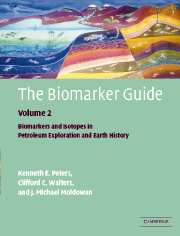Book contents
- Frontmatter
- Contents
- About the authors
- Preface
- Purpose
- Acknowledgments
- PART II BIOMARKERS AND ISOTOPES IN PETROLEUM SYSTEMS AND EARTH HISTORY
- 12 Geochemical correlation and chemometrics
- 13 Source- and age-related biomarker parameters
- 14 Maturity-related biomarker parameters
- 15 Non-biomarker maturity parameters
- 16 Biodegradation parameters
- 17 Tectonic and biotic history of the Earth
- 18 Petroleum systems through time
- 19 Problem areas and further work
- Appendix: geologic time charts
- Glossary
- References
- Index
14 - Maturity-related biomarker parameters
Published online by Cambridge University Press: 05 April 2013
- Frontmatter
- Contents
- About the authors
- Preface
- Purpose
- Acknowledgments
- PART II BIOMARKERS AND ISOTOPES IN PETROLEUM SYSTEMS AND EARTH HISTORY
- 12 Geochemical correlation and chemometrics
- 13 Source- and age-related biomarker parameters
- 14 Maturity-related biomarker parameters
- 15 Non-biomarker maturity parameters
- 16 Biodegradation parameters
- 17 Tectonic and biotic history of the Earth
- 18 Petroleum systems through time
- 19 Problem areas and further work
- Appendix: geologic time charts
- Glossary
- References
- Index
Summary
This chapter explains how biomarker analyses are used to assess thermal maturity. The parameters are arranged by groups of related compounds in the order (1) terpanes, (2) polycadinenes and related products, (3) steranes, (4) aromatic steroids, (5) aromatic hopanoids, and (6) porphyrins. Critical information on specificity and the means for measurement are highlighted before the discussion of each parameter.
Thermal maturity describes the extent of heat-driven reactions that convert sedimentary organic matter into petroleum. For example, kerogen in fine-grained source rocks can be converted thermally to oil and gas, which migrate to coarser-grained reservoir rocks (Figure 1.2). Early diagenetic processes convert bacterial and plant debris in sediments to kerogen (insoluble, particulate organic matter) and bitumen (extractable organic matter). Thermal processes generally associated with burial then convert part of this organic matter to petroleum and, ultimately, to gas and graphite. Petroleum is a complex mixture of metastable products that evolve toward greater thermodynamic stability during maturation.
Note: It is thought that both kerogen and oil are unstable during catagenesis and progressively decompose to pyrobitumen and gases (e.g. Hunt, 1996; Tissot and Welte, 1984). Mango (1991) proposed that hydrocarbons in oil are much more thermally stable than their kerogenous precursors. He believes that oil and gas originate by direct thermal decomposition of kerogen but that hydrocarbons in oils do not thermally decompose to gas in the Earth. This scenario does not exclude some oxidative decomposition of hydrocarbons during thermochemical sulfate reduction (e.g. Orr, 1974; Krouse et al., 1989).
Information
- Type
- Chapter
- Information
- The Biomarker Guide , pp. 608 - 640Publisher: Cambridge University PressPrint publication year: 2004
Accessibility standard: Unknown
Why this information is here
This section outlines the accessibility features of this content - including support for screen readers, full keyboard navigation and high-contrast display options. This may not be relevant for you.Accessibility Information
- 1
- Cited by
